CloudCADI Onboarding
You Are Just A Few Steps Away From Saving Your Cloud Budget.
Introduction
CloudCADI, a flagship product of Amadis is a one suite FinOps solution for all your cloud cost optimization needs. Follow the steps and start leveraging your cloud environment. In case of any queries contact our support team.
Table of Contents
Onboarding Requirements (Azure Active Directory)
Below details are needed for the onboarding process.
- Service Principal: To provide authentication to the created App Service and to provide permission to read data from Log analytics
- Log Analytics Workspace: To configure and read data from Log Analytics, to setup Window and Linux counters
Step 1: Service Principal (Azure Active Directory)
This section provides details about the options that need to be configured to enable Single Sign-On (SSO) for the App Service. It also covers the permissions required for reading data from Log Analytics.
- Login to Azure Portal and Open Azure Active Directory.
- Click on “App Registration”
- Select the “Service Principal” chosen during the Managed App creation.


Step 1.1: App Service Authentication
- From the Managed Section, Click on the “Authentication” Tab
- In the right panel click on the “Add a Platform”
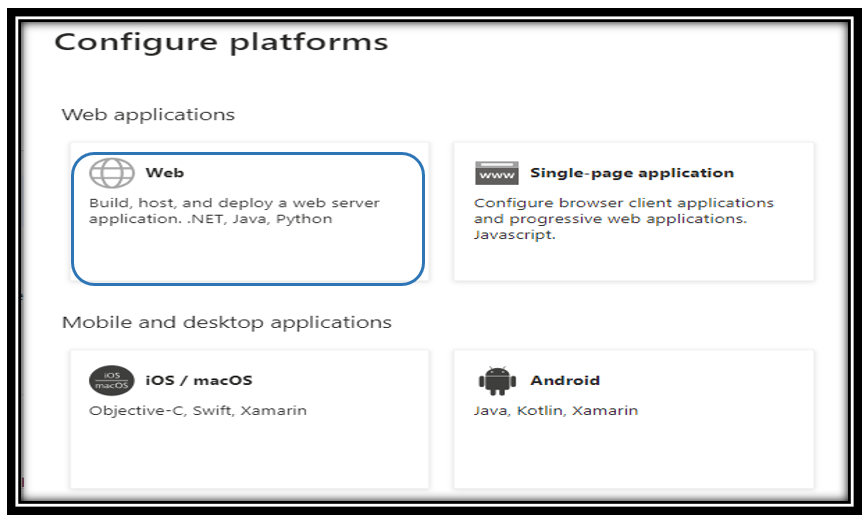
Step 1.1.1: Configure Platforms
- Select Web from the Popup window.
Step 1.1.2: Configure Web
- Enter Redirect URI: https://<App service URL>/api/auth/v2/azure/callback
- Enter Front-channel logout URL: https:// <App service URL>/login.
- In the Implicit grant and hybrid flow, enable Access tokens and Id tokens
- Click ‘Configure’ Button.
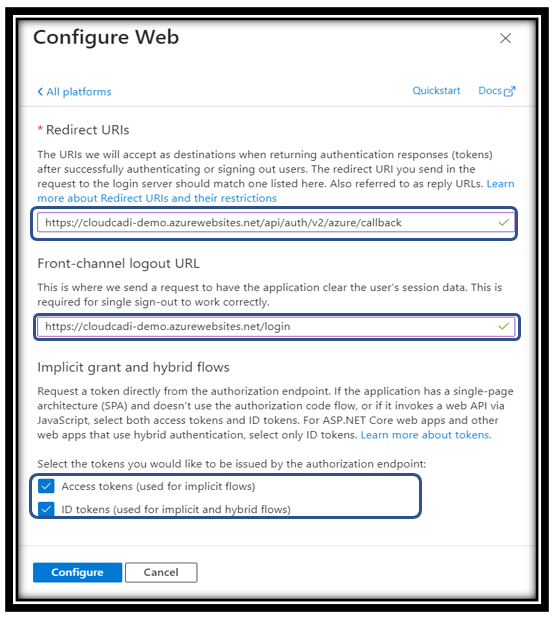
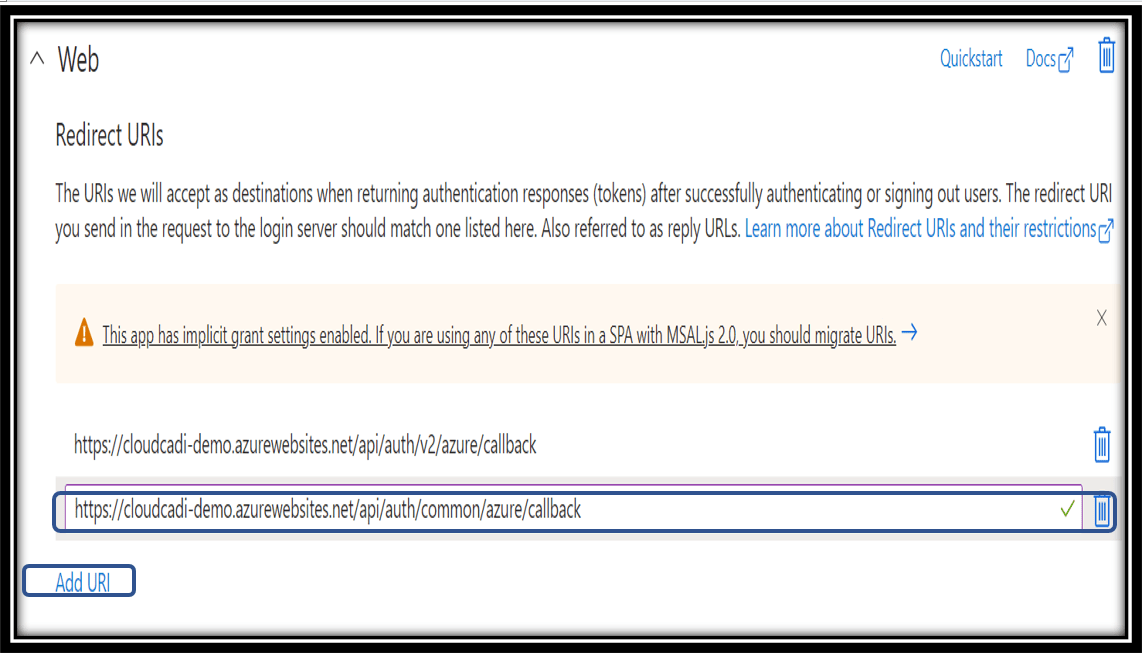
Step 1.1.3: Redirect URI
- Click ADD URI
- Enter new Redirect URIs in the format – https:// <App Service URL>/api/auth/common/azure/callback
- Click Save
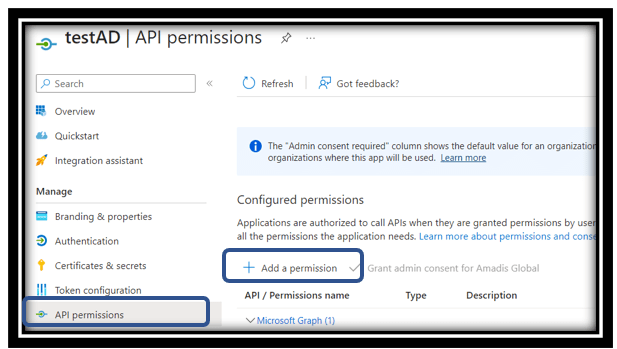
Step 1.2: API Permissions
- From the Managed Section, Select the API Permission and Click on ‘Add a permission’.
- In the “API Permission” Page Click on “Add a Permission”.
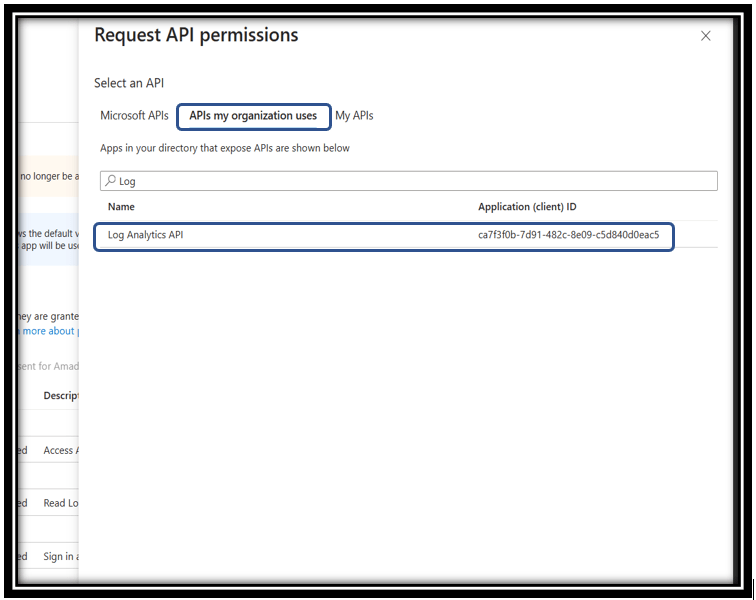
Step 1.2.1: App Service Authentication
- Select “APIs my organization uses” in the Request API Permissions
- Search for Log Analytics API and select it.
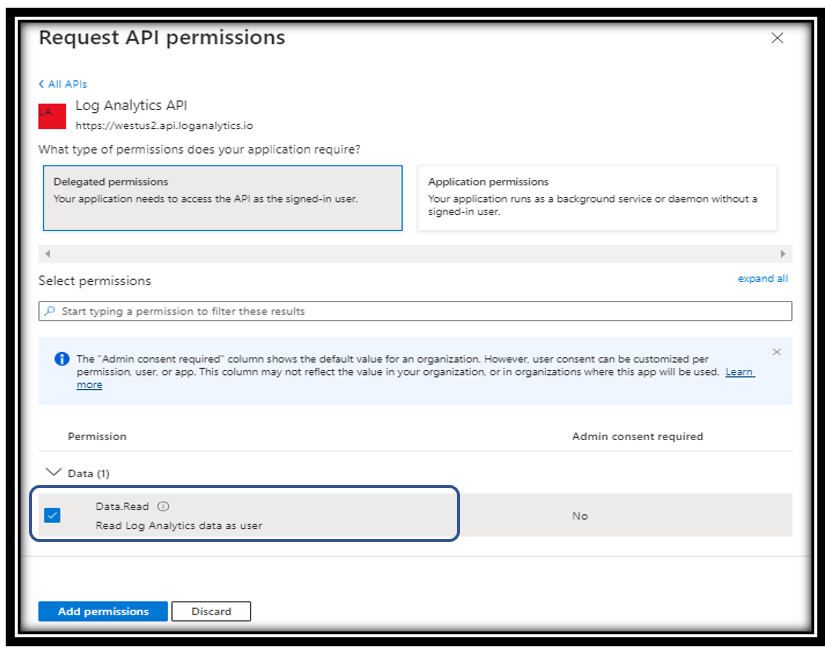
Step 1.2.2: Configure Platforms
- Choose “Delegated Permissions”.
- Enable ‘Data.Read’ in the Data Section and then click “Add Permission” Button.
- You will see the List of Permissions as shown in the below Figure 12.
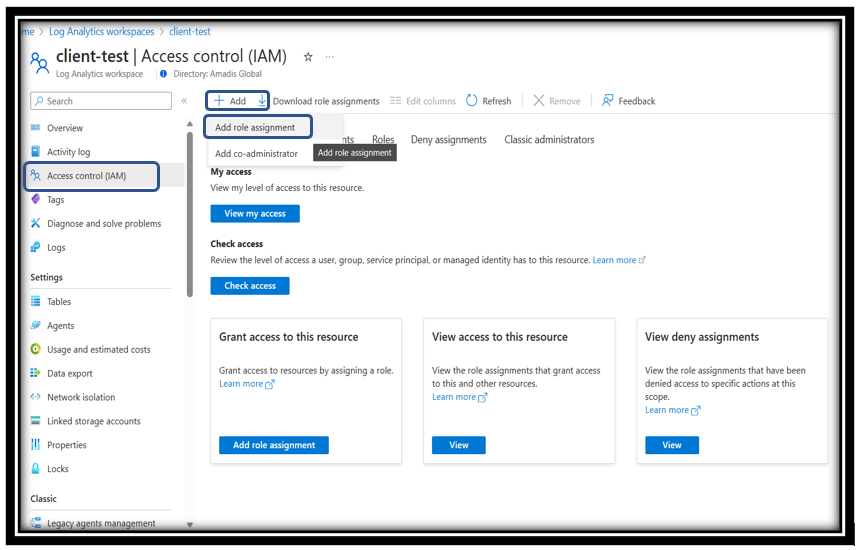
Step 1.2.3: Access Control (IAM)
- This is used to read IP Address for providing unused IP Address Recommendation
- Open “Subscription” from the azure portal
- Select the Access Control (IAM) from the left side panel (Figure: 9).
- Click on “+Add” at the top
- Select “Add Role Assignment”.
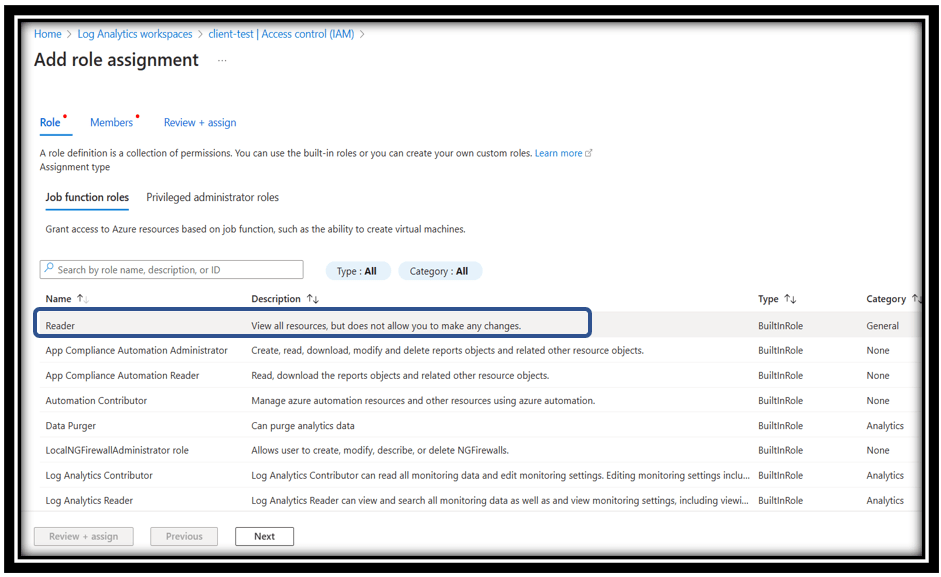
Step 1.2.4: Reader Role
- Search for “Reader” and select “Reader” (Figure: 10).
- Click on “Next” button.
- Select Assign access to as “User, group, or service principal”.
- Choose Member and Click on “Next”
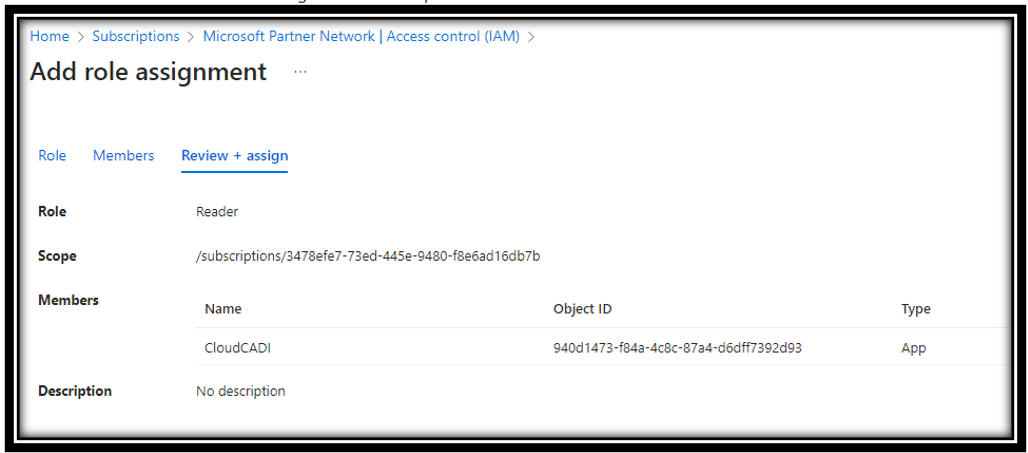
Step 1.2.5: Review & Assign
- Click on “Review + assign” button.
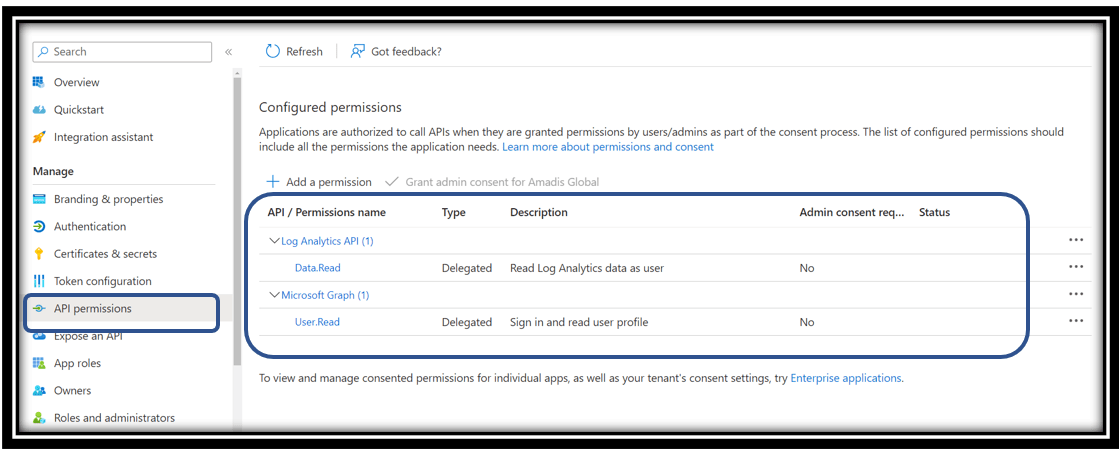
Step 1.2.6: Review & Assign
- Verify the final list of permisions
Step 2: Log Analytics Workspace
- Open the already existing Log analytics from azure portal.
- Click on the under the “classic” on the left navigation bar.
- Note: Step 2.1 and 2.2 should be followed for the use of the existing Log Analytics workspace.
Step 2.1: Windows Performance Counter
- Click on Windows performance counters (Figure 12).
- Click on the “Add performance counter” button.
- Configure the counter with the settings as shown in figure.
- Set the Sample rate to 60 seconds.
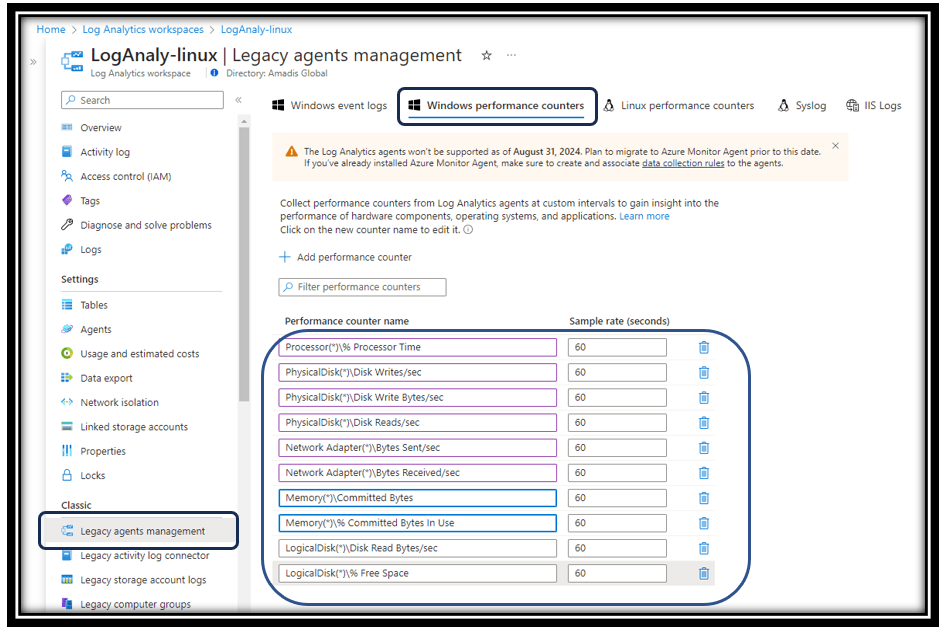
Step 2.2: Linux Performance Counter
- Click on the Linux performance counters (Figure 13).
- Click on the “Add performance counter” button.
- Configure the counter with the settings as shown in figure.
- Set the Sample rate to 60 seconds.

Step 2.3: Connecting VMs to Workspace
The next step is to connect the VMs to the newly created workspace. This can be done in two ways either using a script or manually from the portal.
Step 2.3.1: From Azure Portal
Go to the created workspace. Scroll down to “Workspace Data Sources” then select “Virtual Machines”. This will take you to the page where all the VMs are listed. You can drill down the VMs based on Resource Group, Location, Subscription, Etc. Click on the desired VM. On the following page, if you see the VM already connected to any workspace (even the default one), it can be disconnected and connected to the current workspace. Alternatively, you can assign the Reader Role to the service principal on those workspaces, enabling it to read log data. (Section: 1.2.2)
Step 2.4: Connecting App Service to Workspace
The next step is to connect the app service to the newly created workspace which can be done manually in the portal.
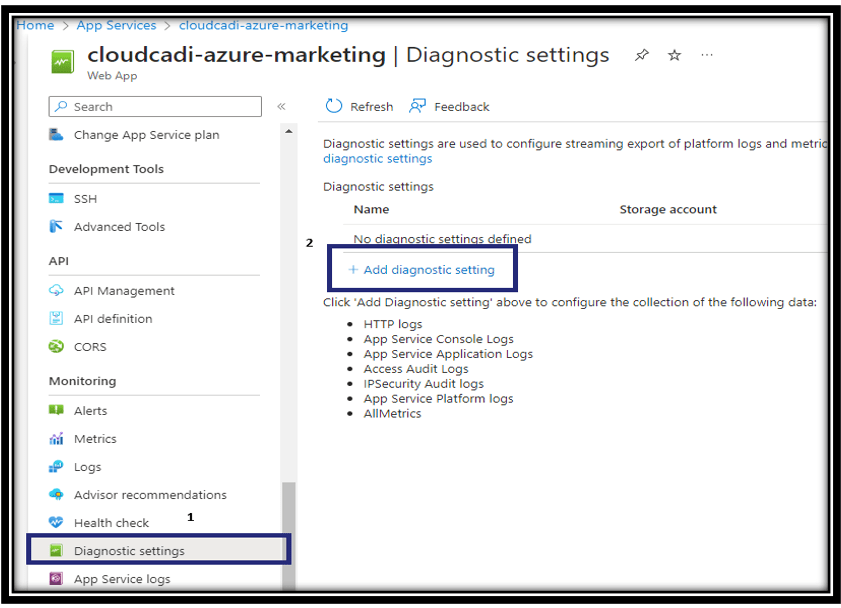
Step 2.4.1: From Azure Portal
- In Azure portal, navigate to App service. Under monitoring (Figure 15), choose the Diagnostic Setting and click “Add diagnostic setting”.

App Service Diagnostic Setting
Provide (Figure 16) the diagnostic setting name, enable all the metrics needed and choose the destination to send to Log analytics workspace, then select the previously configured Log analytics workspace from the list of available workspaces. Click Save to connect app service to the log analytics workspace.
Step 2.5: Connecting the SQL Database to the workspace
- Open the already existing Log analytics from azure portal.
- Click on the under the “classic” on the left navigation bar.
- Note: Step 2.1 and 2.2 should be followed for the use of the existing Log Analytics workspace.
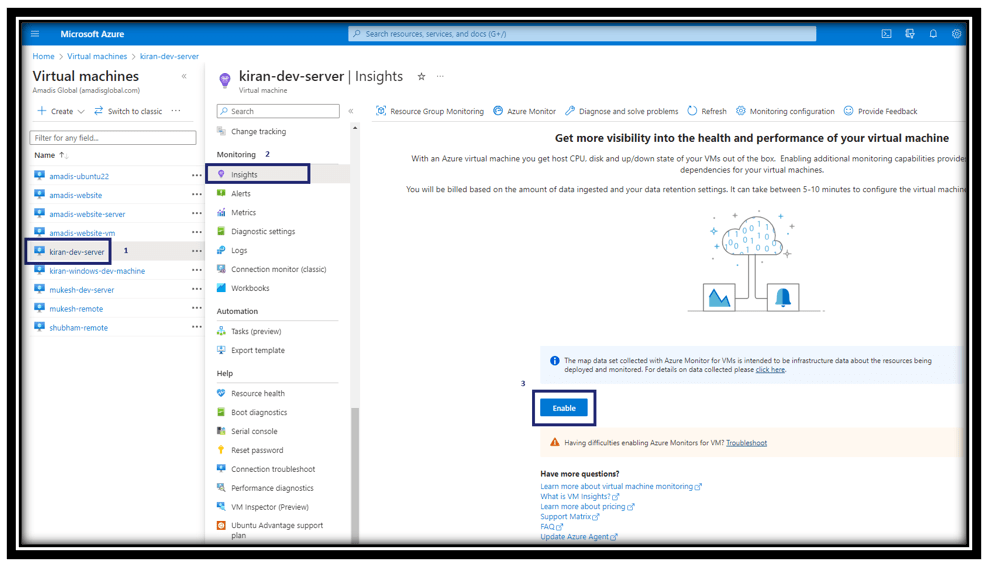
Step 3: Create Data Rules
In Azure portal, navigate to Virtual Machines. Choose (Figure 18) the virtual machine which needs to be monitored, click “Insights” then click “enable” to get the VM and performance resource data.
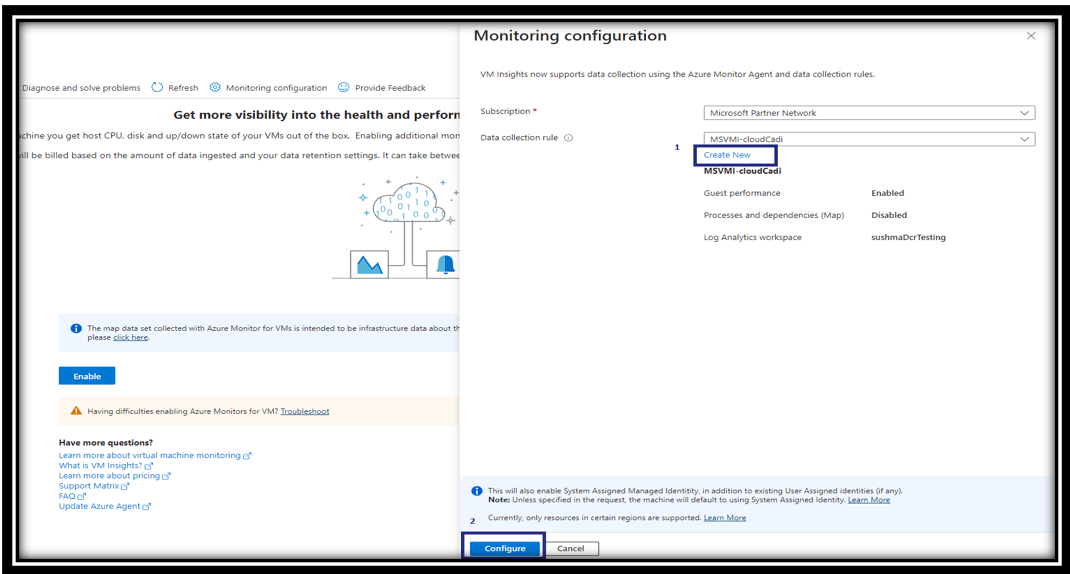
Monitoring Configuration
In the monitoring configuration (Figure 19), to configure VM insights, click “Create New” if need to use a new DCR or choose previously configured DCR from the list of available DCR, then click “Configure”.
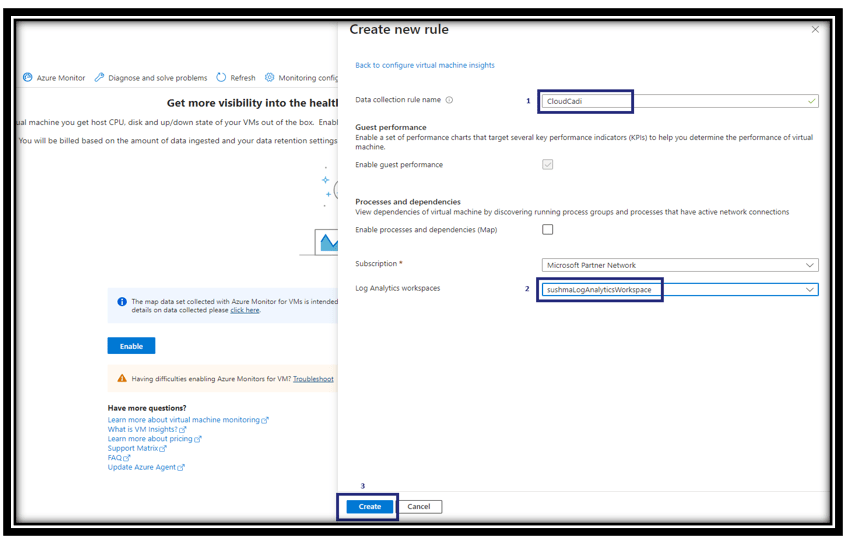
Create New DCR
In the Create new rule section (Figure 20), give the data collection rule name, select the previously configured Log analytics workspace from the list of available workspaces then click “Create”.
Note: Same log analytics workspace can be reused again across DCR.
DCR will be created in the same location as the selected Log Analytics workspace.
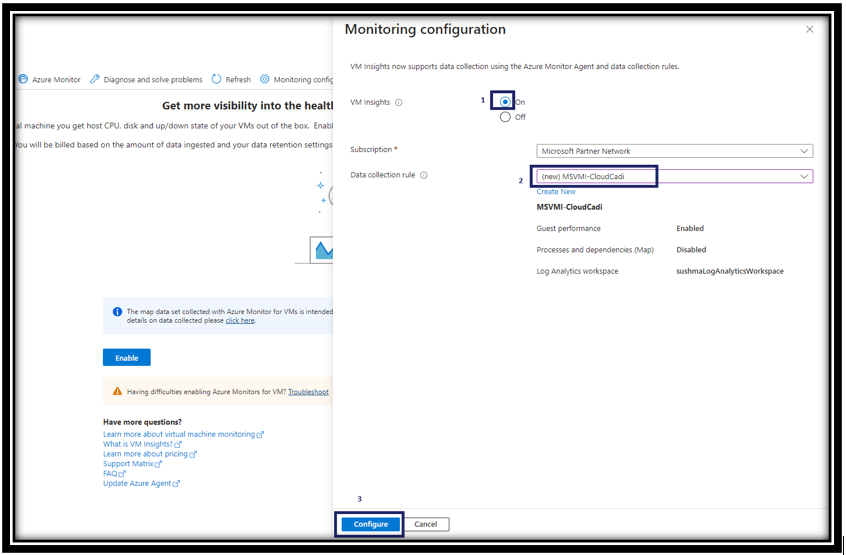
Monitoring Configuration
In the monitoring configuration (Figure 19), to configure VM insights, click “Create New” if need to use a new DCR or choose previously configured DCR from the list of available DCR, then click “Configure”.
Insights Overview
After enabling the VM insights, insights will be shown as (Figure 22).

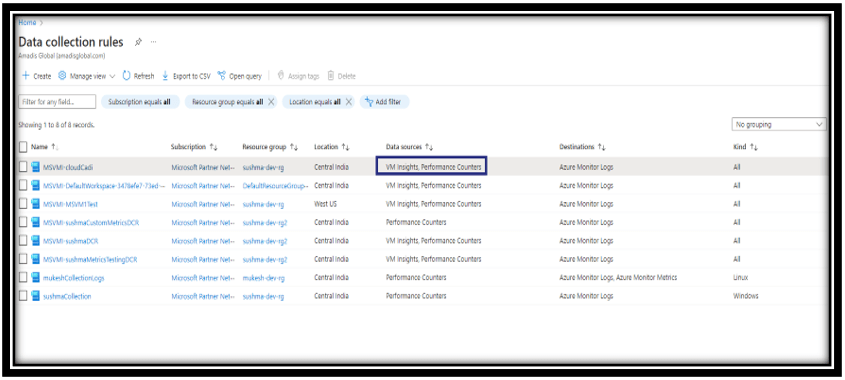
Step 3.1: Add more resource to DCR
In azure portal navigate to Data collection rules, in that can see the created DCR with enabled VM insights and performance counters (Figure 23).
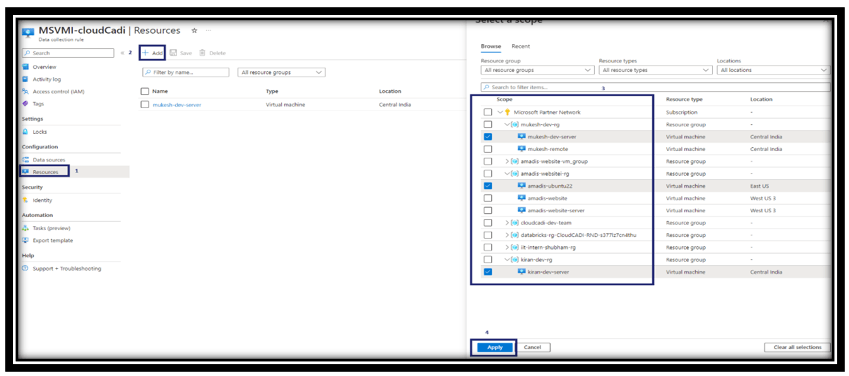
Monitoring Configuration
To add extra VM in DCR (Figure 24), choose the DCR to include resources, click “+ Add”, in the “Select a scope” section choose the resources need to add, then click “Apply”.
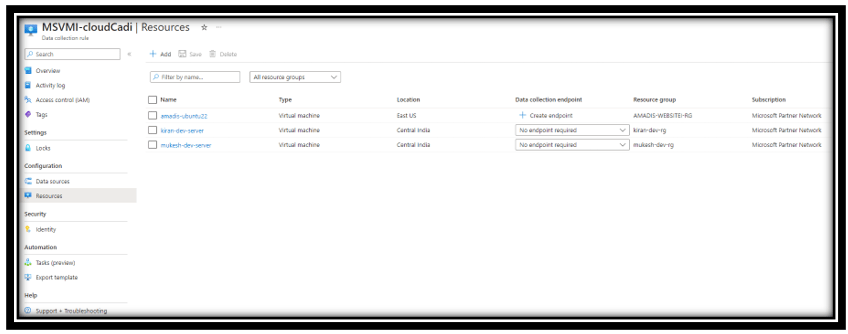
Resources
After adding the resource, it will be shown in the resource list (Figure 25). Logs of these resources will be sent to the selected log analytics workspace.

Monitoring Configuration
In Azure portal, navigate to Virtual Machines. Choose the virtual machine which needs to be monitored, click “Insights” then click “Monitoring configuration” to get the performance resource data.
Monitoring Configuration
Click on edit to change the existing configuration.
Follow the remaining steps from Figure:19 up to Figure:25.

Add more Log Analytics Workspace to DCR
In Azure portal, navigate to Data Collection Rules (DCR). Choose the DCR which needs to add new log analytics workspace.
Click on the Data source and click the Performance Counters. Click on the Destination. Click on +Add destination.
Choose the Destination type as Azure Monitor Logs and choose the required subscription and choose the required log analytics workspace.
Click on Save.

Step 4: CloudCADI Onboarding
Onboarding Process helps to connect your azure account with the CloudCADI The steps are as follows.
- Visit the App Service URL which you created using the managed app.
- Sign In with the organization account.
Step 3.1: Onboarding Steps Microsoft Customer Agreement user (MCA)
This section gives information on how to onboard your MCA Account to CloudCADI. Onboarding helps the CloudCADI application to get your cost and performance data to show it in the product dashboard.
Step 3.1.1: MCA Prerequisites for Cost Export
This section gives details on how to export the cost data into the storage account in the azure portal. Also, it describes how to get the connection string, container name from the storage account and log analytics credentials from the azure portal.
Step 3.1.1.1: Cost Export
- Login to your Azure Portal.
- Go to “Cost Management”.
- Search for “Cost Export” in the search bar.
- Click on “+Add” and provide the details for the diagram below.
- Enter the ‘Name’ as “cloudcadi-exportcost”.
- Enter the ‘Metric’ as “Actual Cost”.
- Enter the ‘Export Type’ as Daily export of month to date costs.
- Mention the preferred start date.
- Please make sure that the ‘toggle’ is enabled as shown in Fig 15
- Choose the ‘storage account’ which gets created during the managed app creation.
- Enter the ‘container name’ as “daily-cost-export”.
- Enter the ‘directory name’ as “cloudcadi-dir”
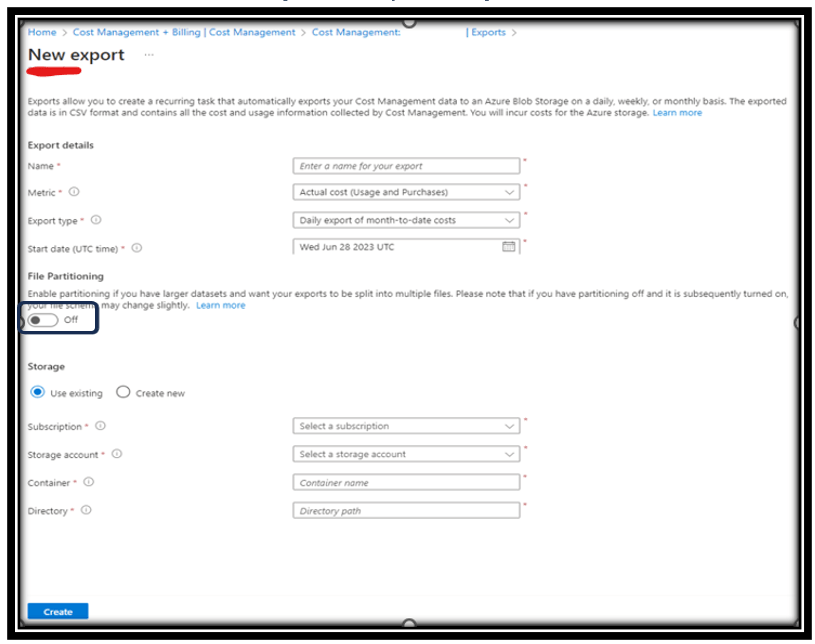
Step 3.1.1.4: For Getting Credentials From Active Directory
- Login to your Azure Portal.
- Open the Azure Active Directory and click on the App registration.
- Open the Service principal which you created or selected during Managed App Creation.
- Under overview Tab, Copy the Application(client) ID and the Directory (tenant) ID.
- In the Left Panel, go to “Certificates & secrets” and Select the Client secrets in the Right Panel. Select the secret key which you create during the managed app Deployment.
- Note: Client secret values cannot be viewed, if you have saved it during the app creation use from that or please create a new client secret.
Step 3.1.1.5: For Getting Workspace ID From Log Analytics
- Open the Log Analytics which we created during the managed app creation.
- In the Overview, copy the workspace Id.
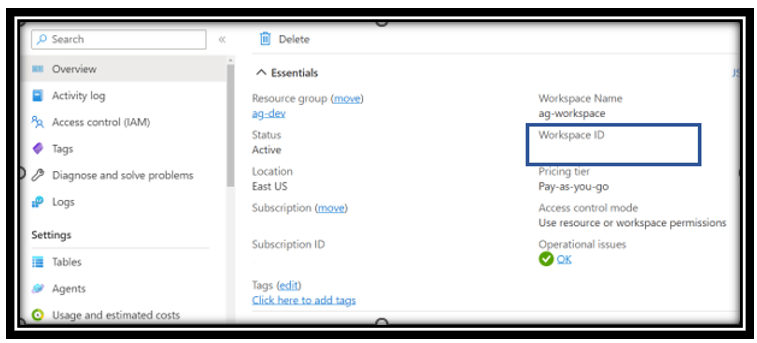
Step 3.1.2: Steps For Onboarding
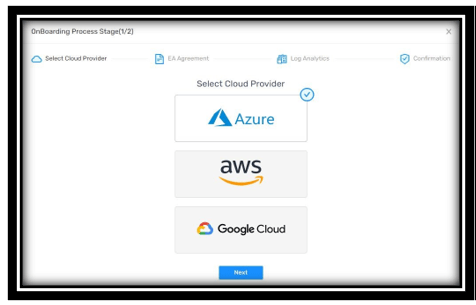
Account Provider
- Open the browser and place the CloudCADI App URL.
- Select the Cloud Provider as “Azure”.

Account Type
- Select the Account Type as “Microsoft Customer Agreement (MCA)”.
- Click Next Button to go to Microsoft Customer Agreement screen (Figure: 20)
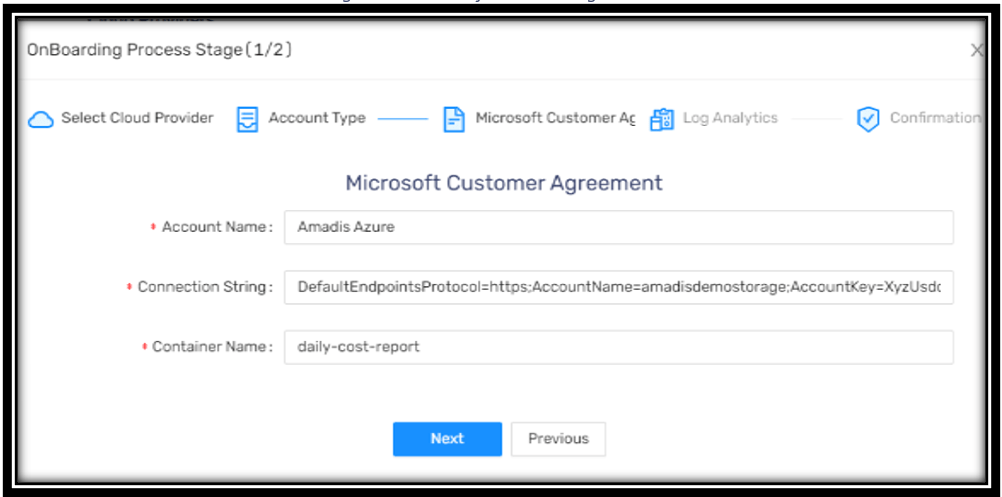
Microsoft Customer Agreement
Refer 3.1.1.2 and 3.1.1.3 to get the ‘Container Name’ and ‘Connection string’ from the Azure Portal.
- After getting the details from the Azure portal, Fill the ‘Container Name’ and ‘Connection String’ in the MCA screen. (Refer Figure: 20) and Click Next.
- OnBoarding Process Stage (1/2) Screen will appear.
- Follow the below steps for getting Tenant Id, Client Id, Client Secret from Active Directory (Refer 3.1.1.4) and Workspace Id from Log Analytics from the Azure Portal (Refer 3.1.1.5)
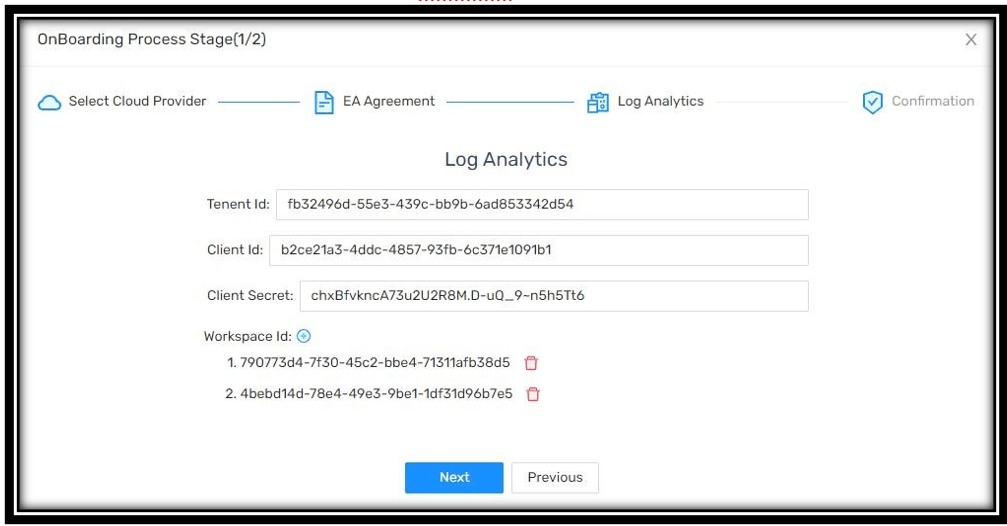
Onboarding Process Stage
After getting the credentials from the Azure portal, fill the details in the OnBoarding Process Stage (1/2) (Refer Figure:28) and Click Next.
- After getting the credentials from the Azure portal, fill the details in the OnBoarding Process Stage 2 (Refer Figure:25) and Click Next.
- You will see the Final View of the CloudCADI Screen with the provided credentials (Figure 26).
- Click on the Done button to finish the Onboarding Process.
Credentials Overview
- Open the Log Analytics which we created during the managed app creation.
- In the Overview, copy the workspace Id.

Credentials
Note: Make a note of the Cloud Account Id and Key which will be useful during the Function App configuration (Refer Figure:24).

Step 3.2: Onboarding Steps - Enterprise Agreement User
This section gives details on how to onboard your EA Account to CloudCADI. Onboarding helps the CloudCADI application to get your cost and performance data to show it in the product dashboard.
Step 3.2.1: EA Cost Prerequisites
This section gives details on how to get the cost data from the EA Portal. Also, it describes how to get the log analytics credentials from the portal.
Step 3.2.1.1: Enrolment Number & Key
Follow this documentation for getting the “Enrollment no” and “Key”.
Step 3.2.1.2: For Getting Credentials From Active Directory
- Login to your Azure Portal.
- Open the Azure Active Directory and click on the App registration.
- Open the Service Principal which you created or selected during Managed App Creation.
- Under overview Tab, Copy the Application(client) ID and the Directory (tenant) ID.
- In the Left Panel, go to “Certificates & secrets” and Select the Client secrets in the Right Panel. Select the secret key which you create during the managed app Deployment.
Note: Client secret values cannot be viewed, if you have saved it during the app creation use from that or please create a new client secret.
Step 3.2.1.2: Get Workspace ID
- Open the Log Analytics which we created during the managed app creation.
- In the Overview, copy the workspace Id (Figure: 22)
Step 3.2.2: Steps For Onboarding

Account Provider
- Open the browser and place the CloudCADI App URL.
- Select the Cloud Provider as “Azure”.

Account Type
- Select the Account Type as “Enterprises Agreement (EA)” (Figure: 26).
- Click Next Button to go to Enterprises Agreement screen (Figure: 27)
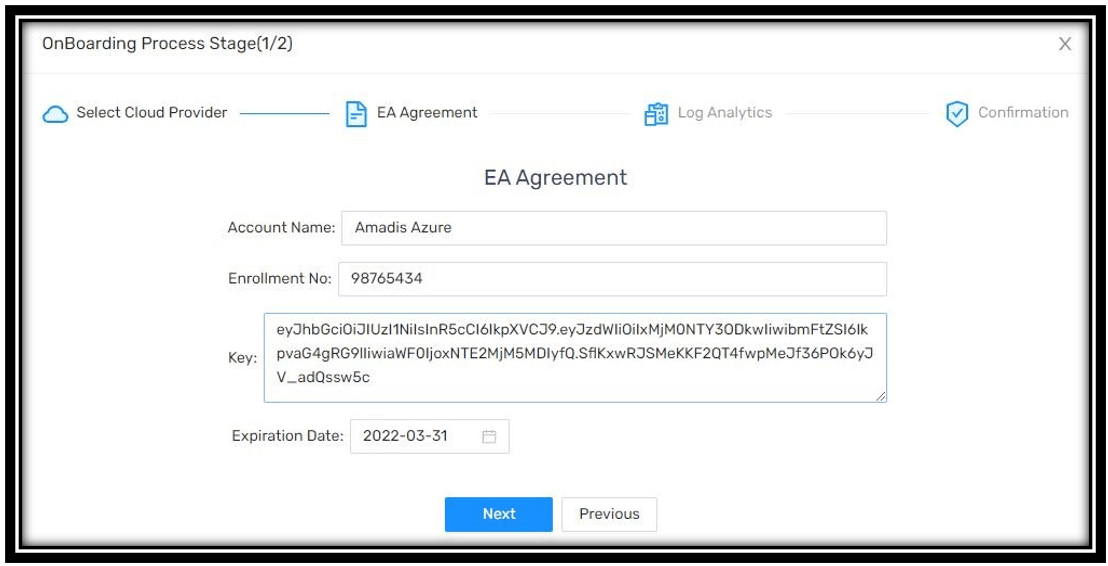
EA Agreement
Follow the EA-Prerequisite document link for getting “Enrollment No” and “Key” from EA Portal. (Refer 3.2.1.1)
- Enter the details and Click Next (Figure: 27).
- Below mentioned OnBoarding Process Stage (1/2) Screen will appear.
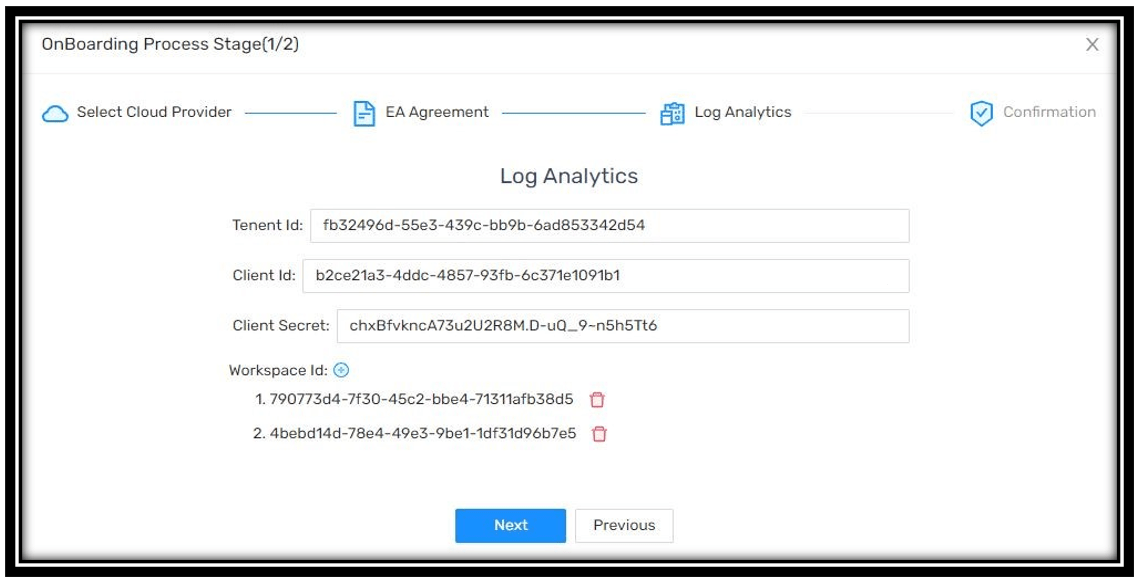
Onboarding Process Stage
Follow the below steps for getting Tenant Id, Client Id, Client Secret from Active Directory (Refer 3.2.1.2 and Workspace Id from Log Analytics from the Azure Portal (Refer 3.2.1.3)
After getting the credentials from the Azure portal, fill the details in the OnBoarding Process Stage (1/2) (Refer Figure:28) and Click Next.
Credentials Overview
- You will see the Final View of the CloudCADI Screen with the provided credentials (Refer Figure:29).
- Click the Done button to finish the Onboarding Process.
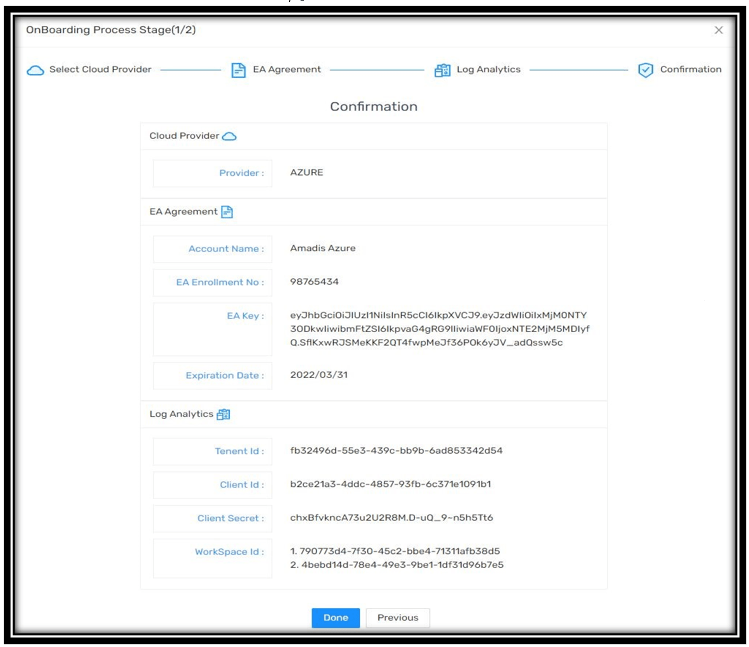
Credentials
Note: Make a note of the Cloud Account Id and Key which will be useful during the Function App configuration (Refer Figure:30).

Step 4: Environmental Setup for Function App
Function App is used to make time trigger that fetches the data from the azure portal and insert into the CloudCADI application using the ‘Cloud Account Id’ and ’Key’ which we created during the CloudCADI Onboarding Step. (Step 3)
Steps for Function App Setup
Open the Function App which gets created during the managed app creation.
Settings Section
- Click on the Configuration tab which is under the settings section
- Under the Application Settings, click on the “New application setting” and add the details below.
- Name= ENDPOINT / Value= “https://<App service URL>”
- Name= CLOUD_ACCOUNT_ID / Value= “Your cloud account Id from onboarding process”
- Name= KEY / Value= “Your KEY from onboarding process”
- Name=FILE_PARTITION/ Value= ”true”
- Click on ‘Save’ on the top to save the configuration.
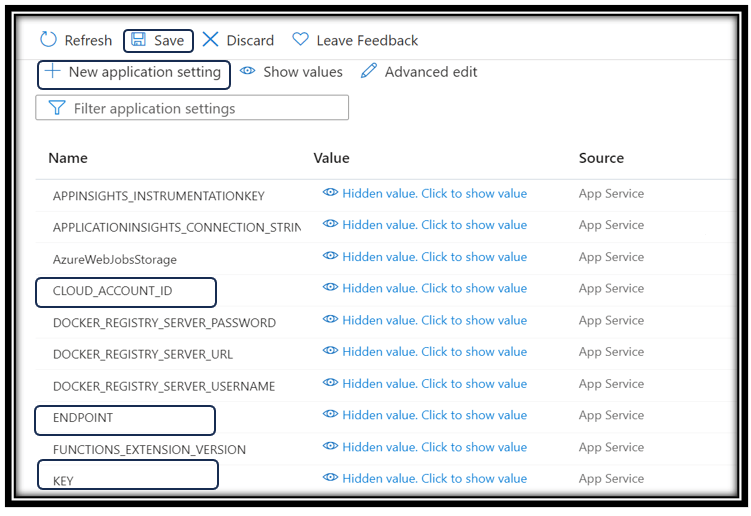
Step 5: Appendices
Below section are used after product Onboarding, during post installation.
5.1 Log Analytics Client secret Key Expiration
5.2 Updating Client Secret in CloudCADI
5.3 Deleting Managed App
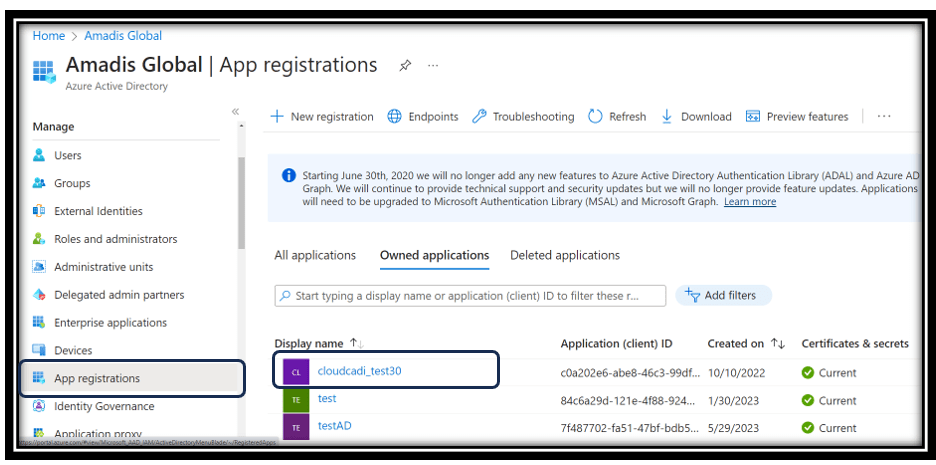
Step 5.1: Log Analytics Client Secret Key Expiration
- Login to Azure portal and open Active Directory
- Click on App Registration
- Select the application for which you want to change the expiration date.
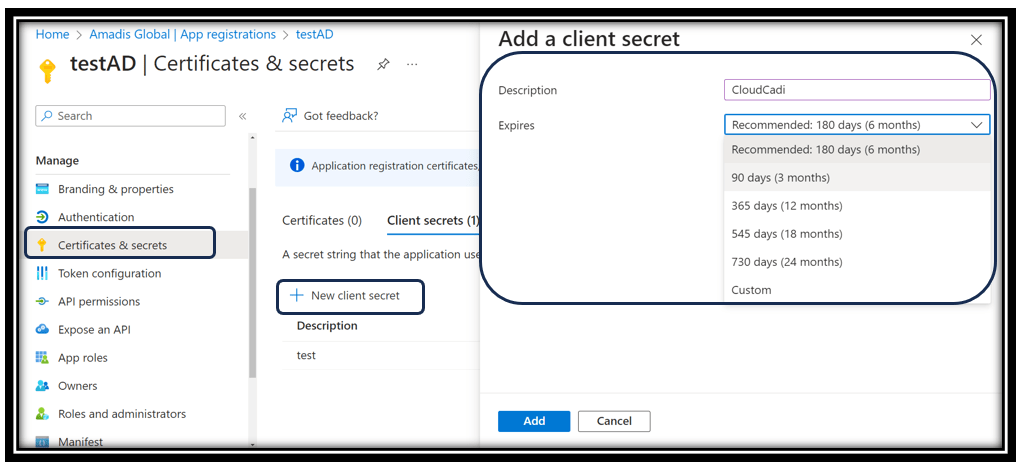
Step 5.2: Certificates and Secrets
- Select Certificates & Secrets under the Manage section.
- Click New Client Secret.
- Enter the description and select the expiration as you want.
Secret ID
- Copy the value (Figure:31) and use it to update the CloudCADI application (Figure:32).
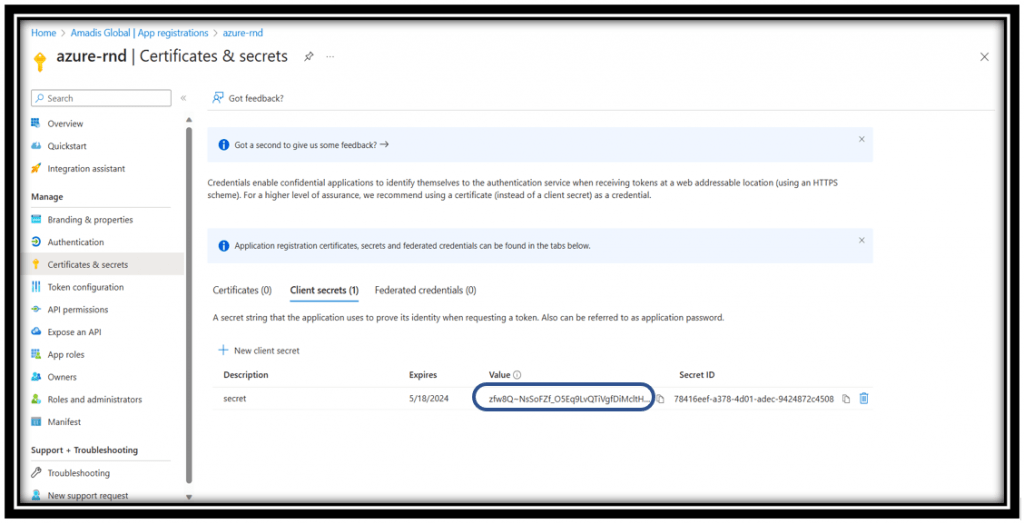
Account Settings
- Open the CloudCADI application.
- Go to settings.
- Select Azure Log Analytics.
- Paste the value which we copy from the client’s secret.
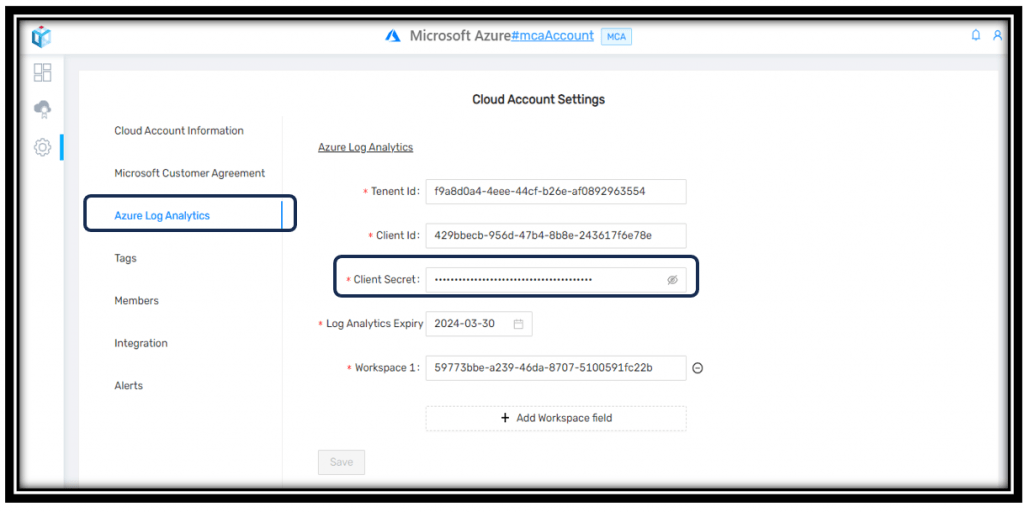
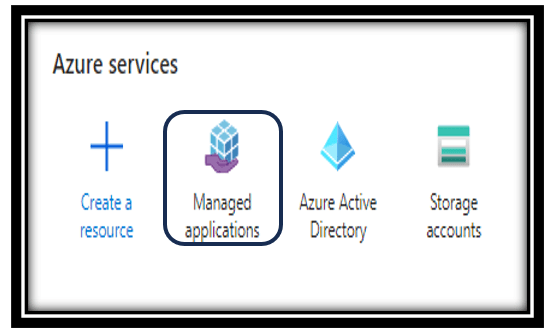
Log Analytics Client Secret Key Expiration
- Open Managed applications from the Azure portal.
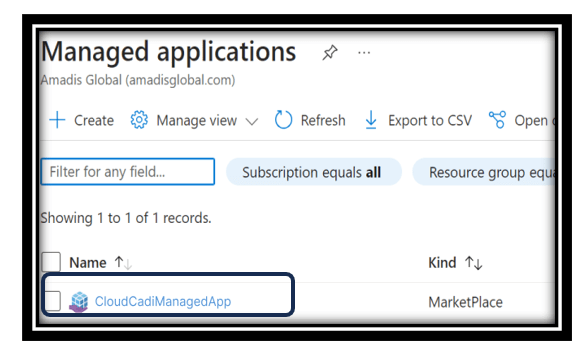
Certificates and Secrets
- Open the Managed application which gets created.
Delete Application
- Click on delete, which will delete all the service created during the managed app deployment.
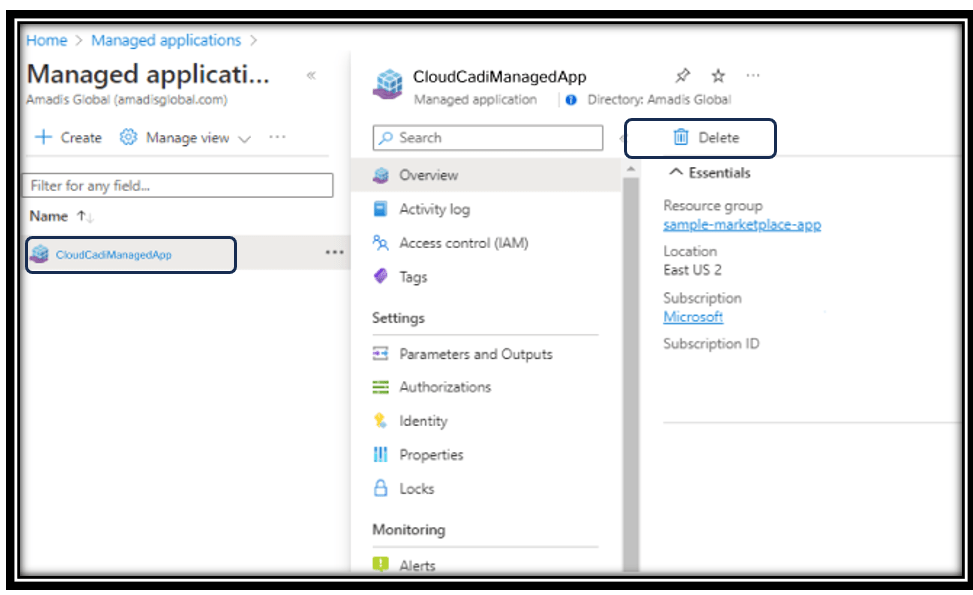
Section 6: Contact & Support
For all your product setup queries fill up this short form outlining your issue. Our support team will get back to you shortly.



